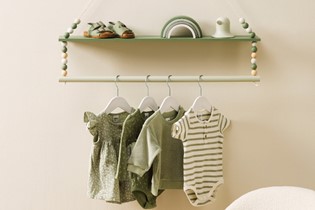The pros and cons of co-sleeping

So you’ve been contact napping, rocking or feeding to sleep, bed sharing (or all of the above) for most of your child’s life. How do you encourage independent sleeping when the time is right? Dorothy Waide explains…
This such a big topic and one close to my heart. Although labelled as a sleep consultant, I am a Karitane mothercraft Nurse and when I trained, we were taught to place our babies in cots and leave them to go to sleep unaided – oh how times have changed! And thank goodness. I have also been fortunate to step into the other, more gentle side of parenting and now take the good bits from both sides when working with families. I learnt very quickly that neither style of parenting is perfect and it does depend on how you want to parent, together with the temperament of your child. We talk about the first 1000 days and how attachment to caregivers is so crucial (and I am totally on-board with this) but in my experience babies and toddlers do need some gentle boundaries if quality sleep is to be on the agenda.
The question I always ask my clients is, "Why do you want to stop doing what you’re currently doing?". If it’s because of pressure from others, then perhaps all that’s needed is a bit of a mind-shift and acceptance that that’s how you like to do things. It takes approximately 20 minutes for a baby/toddler to fall asleep, so I always think taking that time out of your day to be there is really quite lovely. As your child grows, this turns into their special time with their parent before they fall asleep and it can be a really treasured time, so embrace it if you can. However, if there are other reasons you wish to stop – and there can certainly be various reasons why it’s not working for the family – then yes, there are ways.

A WORD ON BED-SHARING
I love bed-sharing. A lot of babies I worked with when I was working as a post-partum care provider overseas for two decades, I bed-shared with. There are some risks associated of course – it isn’t recommended to bed-share with an infant if there is alcohol, cigarette or drug consumption in the home, no loose bedding, sleepwear or pillows, etc. But there are many positives too, if you can ensure it’s done safely. The tricky thing is, at one time or another, parents generally want their bed back to themselves – especially if more children have joined the family since!
FEEDING TO SLEEP/OVERNIGHT
If you're bedsharing plus feeding to sleep and/or feeding overnight (either breast or bottle), I would suggest reducing the night feeds and ultimately stopping this first. Once your baby or toddler doesn't need feeding overnight then you can start to encourage independent sleeping in their own bed and work on falling asleep without any sleep props (this will take time).
Three steps to stop feeding to sleep (each step could take a minimum of 10 days for everyone to adjust to):
- Into pjs or sleeping bag, feed till drowsy and then hold to sleep instead.
- Feed first, then into pjs or sleeping bag, then hold to sleep.
- Feed first, into pjs or sleeping bag, and into cot or bed and touch to sleep (more info on this step later.)

SLEEPING INDEPENDENTLY
Going from the closeness of bed sharing to sleeping independently is hard on everyone, so you might feel inclined to go slowly and do it in little steps. Spend some time settling them and make sure you have the right environment.
If you have a baby then I suggest you set up their cot in their room and place a bed or mattress on the floor. Start with putting your baby in their cot in a dark room (a pitch black room is essential for producing melatonin, the sleep hormone). I would use touch and presence. Place one hand on their chest and one hand on their lower body (touch). If they are moving around, then just step back and lie down on your mattress beside the cot (presence). If touching, close your eyes as they will be looking to you for what to do. If they are really upset and you think it’s at an inappropriate level, pick them up and lie down on the mattress on the floor together. Encourage baby to lie on the mattress beside you rather than on you – this may need to be done in stages over a number of weeks. It might seem like an impossible task at the beginning, but over time you will find that you will be able to leave your baby in the cot and help them to sleep just by touch. Every step takes a minimum of 10 days and the first three to four days are hard while you all adjust, but adjust you will!

In my work I find that a lot of older babies really dislike their cots and get extremely agitated being placed into them or waking up in them if they’ve been supported to sleep elsewhere. In this instance, I would put a mattress on the floor in their room and put side safely rails around part of it. In many cases, babies and toddlers that have been bed-sharing will not accept going back into cots and transition straight to a mattress on the floor instead or into their own big bed.
If you are going to put your older baby/toddler on the floor to sleep then please ensure their room is childproof. No curtain or blind cords within reach, no electric cords hanging around, wardrobes cannot be opened, book cases, sets of drawers are childproof, no excessive toys lying around. If you want to keep the door open I suggest using a child gate as this keeps them safe in their rooms overnight. If you're lying down with your older baby/toddler in their bed, make sure you are calm and close your eyes – model what to do.
For the night walkers that come into your room overnight and climb into bed (again, if this works for you then no need to change), a transition solution can be putting a mattress on the floor in your room for them. Explain before they go to bed at night that it’s time for mummy and daddy to have their own bed and if they want to come into your room, they can lie on their special mattress.
Going to sleep in their own beds (firstly with your assistance and then eventually on their own) and doing their first stretch of sleep independently is the first step. Once you've mastered that, then you can work on getting them to stay in their beds on their own all night (and sometimes this just happens naturally overtime). There are various ways to go about encouraging them to settle themselves to sleep, and it will largely depend on their temperaments. It’s very difficult to give a specific recommendation without knowing the child or history, but some options you might like to find out more about are:
STAYING IN THE ROOM
This is where you will put your older baby/toddler into their cot or bed and then stay in the room until they go to sleep. Sometimes, this is enough of a change for families and they’re happy to stop here. There is nothing wrong with supporting your little one to sleep, no matter how old. If you’d like to take it a step further, instead of lying on the floor or a mattress together (as you may have started out doing as a first step after bed-sharing), you will sit next to the cot or bed and use touch and presence until they go to sleep. The next step is to distance yourself slowly away from the cot/bed until you are sitting by the door and eventually sitting outside the door. Each step takes a good 10 days. The aim of the game here is to ease them out of needing you to fall asleep.
IN AND OUT
This is where you put your older baby/toddler into bed, say goodnight and leave the room while they’re still awake. If they are upset, leave them for an appropriate time and appropriate noise (you decide what that is based on your own child and yourself) and then go back in and verbally tell them that it’s time to go to sleep and give them a cuddle and back into their bed or cot. Continue to do this until finally they go to sleep, or at the 20 minute mark, you can then stay in the room until they go to sleep and try again tomorrow.
SPACED SOOTHING
This is similar to the above but with a regimented time frame set on how long you wait to go in and soothe. The time you stay out of the room is the same length of time regardless of what the noise is. Again, after 20 minutes if they’re still not asleep they will be passing over into overtiredness and it’s best to assist to sleep and try again tomorrow.
PICK ME UP AND PUT ME DOWN
This again is similar to both of the ways above except when you go back into the room you pick them up and give them a cuddle and then back into the cot or bed and leave the room. Again, it’s all about set time frames. You continue to do this at spaced intervals until they go to sleep or again, stay in the room and assist after the 20 minute mark.
I hope I have provided some examples of how families might like to slowly encourage some more independent sleeping habits for their little and not- so-little ones. Like almost everything with parenting, it will take time – it’s a big adjustment for them and please do seek professional advice if you’re struggling. Whatever style you choose is the right choice for you and your family.
However you parent, please believe in yourselves. YOU are the baby whisperer and your child’s best expert. Sometimes we do things just to survive and that is okay – it’s called good parenting.
Dorothy Waide is a Karitane Mothercraft Nurse with over three decades of experience. She's also the OHbaby! expert sleep advisor and resident baby whisperer. Dorothy is the author of two popular parenting books, You Simply Can’t Spoil A Newborn and Simply Parenting: From 12 Weeks to 12 Months. Visit Dorothy at babyhelp.co.nz.

AS FEATURED IN ISSUE 57 OF OHbaby! MAGAZINE. CHECK OUT OTHER ARTICLES IN THIS ISSUE BELOW

















